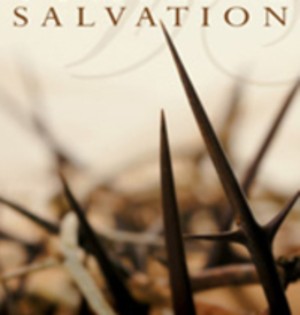Okay, so I will not pretend that I can summarize an entire religious text of 531 pages into a short 3-paragraph format. Please know that I’m trying to hit the points that differ greatly from any Biblical account just to demonstrate what makes the LDS doctrine unique from orthodox Christianity.
According to Mormons, the Book of Mormon is an account of God’s relationship with the original inhabitants of the Americas from about 2240 BC until AD 421. The book gives a story of three groups of peoples.
The Jaredites (Book of Ether) came to the new world at the time of the tower of Babel. God preserved their language, and they were instructed to build eight barges, which traveled underwater and had both a hole in the top and in the bottom, in which to sail to America. This journey took three hundred and forty four days. After years of occupying the land and numbering in the millions, their civilization was destroyed by war. The last two survivors—two generals—were named Coriantumr and Shiz. Shiz was killed by Coriamtumr, who was “destroyed by the hand of the Lord” that same day, thus wiping the entire lineage off of the face of the earth.
However, the two main groups in the Book of Mormon are the Nephites and Lamanites. The story tells of a family group led by an Israelite prophet named Lehi. He is warned by God to flee Jerusalem around 600 B.C. He and his family make their way to the southern part of Arabia where they build a ship to sail across the Pacific Ocean to America after waiting 7 years for God’s instruction. Two of his sons, Nephi and Laman, struggle for leadership. This leads to the division of the group into two warring factions, the Nephites (usually the good guys), who were described as an “exceedingly fair and delightsome people (4 Nephi 1:10) and Lamanites (usually the bad guys), who rebelled against God and was punished in the form of darkened skin. The last battle between the two groups, in 421 AD, wipes out almost all of the Nephites. The son of Mormon, Moroni, the last surviving Nephite, buries the records—captured on golden plates—of his civilization in the hill Cumorah. Hundreds of years later, Joseph Smith is directed to the spot by Moroni. The last survivors of this great migrations were the Lamanites, who are the ancestors of the Native American Indians.
The remainder of the book tells of Jesus’ visit with the remaining peoples following his resurrection. It seems that while in the Americas, he gave the Sermon on the Mount, including the Lord’s Prayer and the Beatitudes. He healed masses of people and thousands were able to touch the wounds from his crucifixion. He feeds the multitudes, establishes his church and predicts the coming of the Book of Mormon.
********************
There is nothing Biblical that I can present here except the following:
There is nothing to Biblically support that any of these events ever occurred or were even necessary. The teaching of the Jaredites is actually a contradiction of the Biblical account of the Tower of Babel. If you read Genesis 11:8-9, you can easily see that the language of “all of the people of the earth” was confounded. How, then, can there be an exception outside of what the Bible states (even the Inspired Version by Joseph Smith)? There can’t.
The LDS members might even try to convince you that they are the “lost sheep” spoken of in Matthew 15:24. However, if you look at verses 5 and 6 of that chapter, you can easily see that Jesus was not instructing them to seek out the lost sheep of Israel. In fact, He stated not to go into other countries or unto the Gentiles at that time.
********************
I have no real commentary. That is the story told by the Book of Mormon. Parts of it are nice, parts are reminiscent of the Bible stories you probably already know, and parts are just plain crazy if you read them literally. However, we will dive deeper into the “crazy” parts later. For now, lets get to the questions:
********************
- Don't you believe that a barge that had a hole in the top and the bottom would sink….quickly?
- How did people and animals survive starvation and disease while traveling aboard an enclosed barge for almost an entire year?
- If there were large-scale wars in which hundreds of thousands of people were killed in AD 385 near Hill Cumorah (most likely in present day New York state), wouldn’t we find huge amounts of archaeological evidence such as weapons, human remains, etc?
- Since the LDS church owns the property at the Hill Cumorah in New York, would it not be wise to turn it over for an archaeological dig to once and all prove the Book of Mormon accounts of the ancient people of the Americas?
- Did you know that Matthew 6:13 and 3 Nephi 13:13 quote the Lord’s Prayer as "lead us not into temptation, but deliver us from evil"? However, based on a present-day clearer understanding of the language, a better translation would have been, "and do not bring us to the time of trial, but rescue us from the evil one". Do you think that it is strange that the King James translators and the inspired Book of Mormon translated it incorrectly in the same manner?
- Peter’s sermon at Pentecost in Acts 3:22 (A prophet shall the Lord your God raise up unto you of your brethren, like unto me; him shall ye hear in all things whatsoever he shall say unto you) paraphrases Moses’ speaking in Deuteronomy 18:15-19, not claiming itself to be a direct quote. However, in 1 Nephi 22:20 (A prophet shall the Lord your God raise up unto you, like unto me; him shall ye hear in all things whatsoever he shall say unto you), Nephi quotes Peter's paraphrase identically, not those words of Moses himself. Isn't it peculiar that these two men would paraphrase Moses exactly? Nephi could not have been quoting Peter because these words were written around 600 BC which Peter's words were obviously stated after Jesus' resurrection and ascension.
Study of the LDS Church - 2.5 The Book of Mormon - The Origin






3 comments:
Kaye,
I suspect from the comments you’ve made that you haven’t read the Book of Mormon—and have quoted from a secondary source. I think that’s why you’ve placed “destroyed by the hand of the Lord” in quotes referring to Shiz-- when the Book of Mormon never provides those words referring to Shiz’s death. You’ll surely be ahead of the game if what you place in quotations really is a quotation.
Similarly, you claim that “all of the people of the earth” (in quotes) were confounded—yet, I can’t find a single Bible translation with that phrase. Do you understand this passage to teach that every single person on the earth began to speak a new language with no exceptions? I don’t that the text demands such a narrow interpretation.
Your paragraph on “lost sheep” is a bit unclear. Who are the “they” you are referring to—LDS people or the people of the Book of Mormon? If your claim that Matthew 15:24 excludes the people of the Book of Mormon, you should realize that they (Nephites and Lamanites) were not Gentiles but actually Israelites; consequently, there would have been no reason not for them to be taught by Christ.
Suggestions for your questions:
1. The answer to place a hole in the top and bottom was to solve a ventilation problem. It would hardly solve the problem if the hole were below the water line would it? Take a look at any ship and you’ll see that there are places in the bottom portion of a boat that are well above the water line.
2. What makes you think it would have been entirely enclosed for the duration of the voyage? You realize that Noah and he family were enclosed with thousands of animals for six months. Do you have the same criticism of the Bible?
3. There isn’t anything in the text of the Book of Mormon that requires the account to have occurred in the vicinity of New York.
4. See number 3 above.
5. Did you know that an angel from heaven misquoted the Old Testament in speaking to John—by using the same text as the existing Septuagint? If angels can use existing translations, why can’t Joseph Smith?
6. Actually, the Book of Mormon account takes place a year following the resurrection while Peter’s sermon was only 50 days following the resurrection.
Alma--
Thank you for reading and for providing conversation in the comments. I welcome the commentary from all views.
The "destroyed by the hand of the Lord" is from Ether 1:1 which states that the Jaredites were destroyed by the hand of the Lord and therefore I applied it to Shiz, since he was one of those people. It therefore is a quote from the BoM, just not from the battle scene, although it does indicate that it applies to the Jaredites as a people.
You are right that the "all of the people of the earth" is not an exact quote and that is my fault entirely. The actual quote is from Genesis 11:9 which does say, "...because the Lord did there confound the language of all the earth...". So yes, it was a misquote, but yes, it does indicate that it happened worldwide with a literal reading of the scripture.
In Matthew 15:24, Jesus instructed his disciples to find the lost Jews...and you are right in defending the LDS belief that the inhabitants of the Americas in the BoM were descendants of the Israelites. The disciples obeyed Jesus' command by taking the message to the lost Jews of their surrounding cities. There is no indication given that any of the disciples obeyed Jesus by coming to the Americas to speak with the Book of Mormon peoples.
I will stop here for a little while, as it is time for me to pick up my son from school. I will continue this discussion either later tonight (if possible) or tomorrow. Please be sure to return for my continued responses.
Okay, Alma--sorry for the delay, but family life keeps one busy, you know.
Now...to reply to the answers you gave to the questions in my post:
1.) I know there are holes in ships but I was simply stating a simplistic view of one of the problems with the barges. The holes in them were an afterthought...commanded only after the soon-to-be passengers pointed out that there would not be air or light. That in itself does not speak of an all-knowing God to me. I am shocked that these submarine type vessels had no windows or view of the outside but were meant to be steered. The vessels all landed together in the new country despite being tossed about, submerged, and blown about by furious winds. How in the world did one fit food and water on 8 barges no larger than a tree for all of the passengers, including water? There are others, but I will not use this entire comment to go over them...
2.) Noah and his family had a much larger ship that floated atop the water the entire flood. Never did they need to submerge and it floated...not was steered. The problems of the barges is not seen in the design of ark. So no, I don't have the same problem with the Biblical account of Noah.
3.) You are right that there is speculation among LDS scholars as to the location of the Cumorah of the Book of Mormon. As it seems implausible that it be in New York, they have started looking elsewhere for it. Have they found it? It seems that early LDS teachers thought that Cumorah was in New York. Orson Pratt stated that it was the same Cumorah where Joseph Smith found the plates several times(Journal of Disclosures v14 p331; v17 p 24; v20 p 62; v22 p224), as did prophets of the LDS chuch (President Anthony W. Ivins, Conference Report, April 1928-Morning Session; Joseph Fielding Smith, Doctrines of Salvation , Vol.3, Bookcraft, 1956, p.232-43) as well as other publications (Articles of Faith , chapter 14; The Latter-day Saints' Messenger and Advocate, Vol.2, No.2, p.221; Ensign Nov. 1975 pg. 35; and Studies of the Book of Mormon, p.277). These can all be seen here.
4.) If the hill in NY is not the one in the BoM, this question could easily rest. However, it seems that in the past, many leaders of the church (including Prophets) noted that it was.
5.) Here's the difference between the Bible and the BoM that I haven't been able to effectively communicate with LDS members...the Bible is translated by human translators and if a group of people are translating the Bible as a whole, a quote in one spot will be translated the same way in another. These mistranslations have been found and corrected in versions since the mistakes were made by men who did not claim that they were more than humble servants of God with their own fallacies. However, when two separate books were translated by two separates people (or groups of people), and one of them claims that the translation could not continue until every word was even spelled correctly, I have a problem with the fact that one of them has errors. It seems interesting that two separate people mistranslated something the exact same way in totally different circumstances. The laws of chance don't really allow for that.
6.) You are correct in the fact that I used the incorrect quoting of this passage. The one I meant to point out was not Jesus' sermon in 3 Nephi, but Nephi's words in 1 Nephi, which was supposedly written about 600 BC. I have corrected the blog post and you are welcome to visit it now and reread my argument.
Thanks again for visiting and I welcome any further discussion/rebuttal that you or anyone else would like to add.
Post a Comment